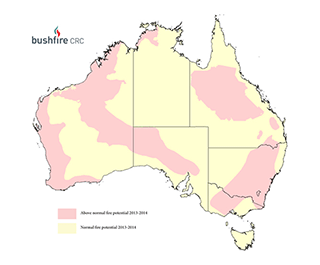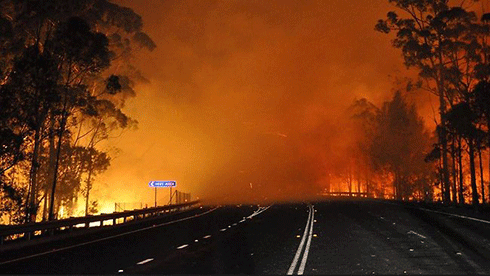
|
Published: 16 September 2013
Bushfires can occur year round: we have to be prepared
Last week’s fires in Sydney’s western outskirts are a timely warning for all Australian communities. Being prepared for a bushfire is not just a summer job – communities in bushfire prone areas, and in the ever-expanding urban/rural interface surrounding our cities and major towns, need to be prepared 12 months of the year.
When the conditions are right, hot and windy days, with dry vegetation, fires will occur. They are a fact of life in the environment we live in. We all must be vigilant about our local conditions.
An earlier fire season?
While summer is usually the time associated with the highest bushfire risk in the southern states across Australia, bushfire seasons are starting earlier and lasting longer.
With these longer fire seasons, fire agencies need to continually refine the education and warning messages for communities in fire prone areas. Much of the new research into bushfires is now about how best to keep communities educated and informed about these changing and evolving circumstances.
Part of this is the Bushfire Cooperative Research Centre (CRC) seasonal bushfire outlooks. Every year since 2006, before the northern and southern Australian fire seasons, the Bushfire CRC has brought together fire managers from all states and territories with Bureau of Meteorology scientists to produce seasonal bushfire outlooks for the relevant fire season. The seasonal outlooks are a useful insight for fire and land management agencies about the expected fire season, so they can plan accordingly.
What’s the outlook?
Broadly, there are two fire seasons in Australia – northern and southern fire seasons. Across northern Australia, the fire season coincides with the northern dry season during winter.
In southern Australia, the fire season begins later in the year, in the lead up to, and including, summer. Depending on the location and conditions experienced, southern Australia’s fire season can run through to March or April.

|
|
Bushfire CRC seasonal outlook: pink areas show above-average bushfire risk for 2013–14. Credit:
Bushfire CRC
|
A few weeks back, the Bushfire CRC released the Southern Australia Seasonal Bushfire Outlook for this fire season. You can see from the map above that large areas of southern Australia, especially along the east and west coasts extending inland, face above normal fire potential for this fire season.
This above-normal forecast is due to abundant grass growth across inland Australia, as a result of above average rainfall between May and July 2013. Grass fuels grow quickly, and this short burst of above average rainfall across inland Australia, coupled with above average temperatures across the country since January 2013, has been enough for the above normal bushfire potential to be declared.
In forested areas, a combination of factors, such as Australia’s hottest summer on record and above-average temperatures over winter, has seen the bush begin to dry out.
How can we be prepared?
We know that bushfires will happen in Australia every year. But we also know from research on recent large fires that many people living in high risk bushfire areas are still under-prepared and ill-informed on the dangers and the preparations needed.
Changes to bushfire policies in the last decade have seen increased emphasis on early warning, focus on protection of human life over fighting the fires, the need for shared responsibility between official agencies and the community for bushfire safety, and the use of personal bushfire survival planning and protection areas around the home.
This change in the way that bushfires, and indeed other hazards, are managed has been strengthened by the extensive and concerted research efforts. The psychological motivations and other reasons behind an individual’s decision to act or not to act in advance of a fire, sometimes despite their best intentions, is better understood by fire agencies applying the research.
The scope of work such this, so important in helping agencies communicate fire preparedness, has now been extended to include other natural hazards in Australia through the newly formed Bushfire and Natural Hazards CRC. There are many common areas between fire and other hazards. For example, with fire and flood, community issues are comparable, response issues and incident management are similar and recovery issues have many common threads.
The bushfires on Sydney’s urban/rural fringe last week, before the official, declared fire season in New South Wales, are another demonstration that we do not know everything about being prepared for emergencies. We need to urgently find new and better ways to help people understand what it means to live with threat of bushfire, flood, cyclone and other natural hazards, year round.
We need to ensure lessons are learnt from each event, and that policies and practices are changed, based on sound, scientific research, to safeguard the community. There is still a lot more to do.
Dr Richard Thornton is the former Deputy CEO and Research Director of the Bushfire CRC. He is also a member of the Board of the International Association of Wildland Fire and the Chair of the Editorial Advisory Committee of the International Journal of Wildland Fire. Dr Thornton was also was the Project Director for the research-data collection taskforce project undertaken after the February 2009 bushfires in Victoria. This article was originally published at The Conversation.




